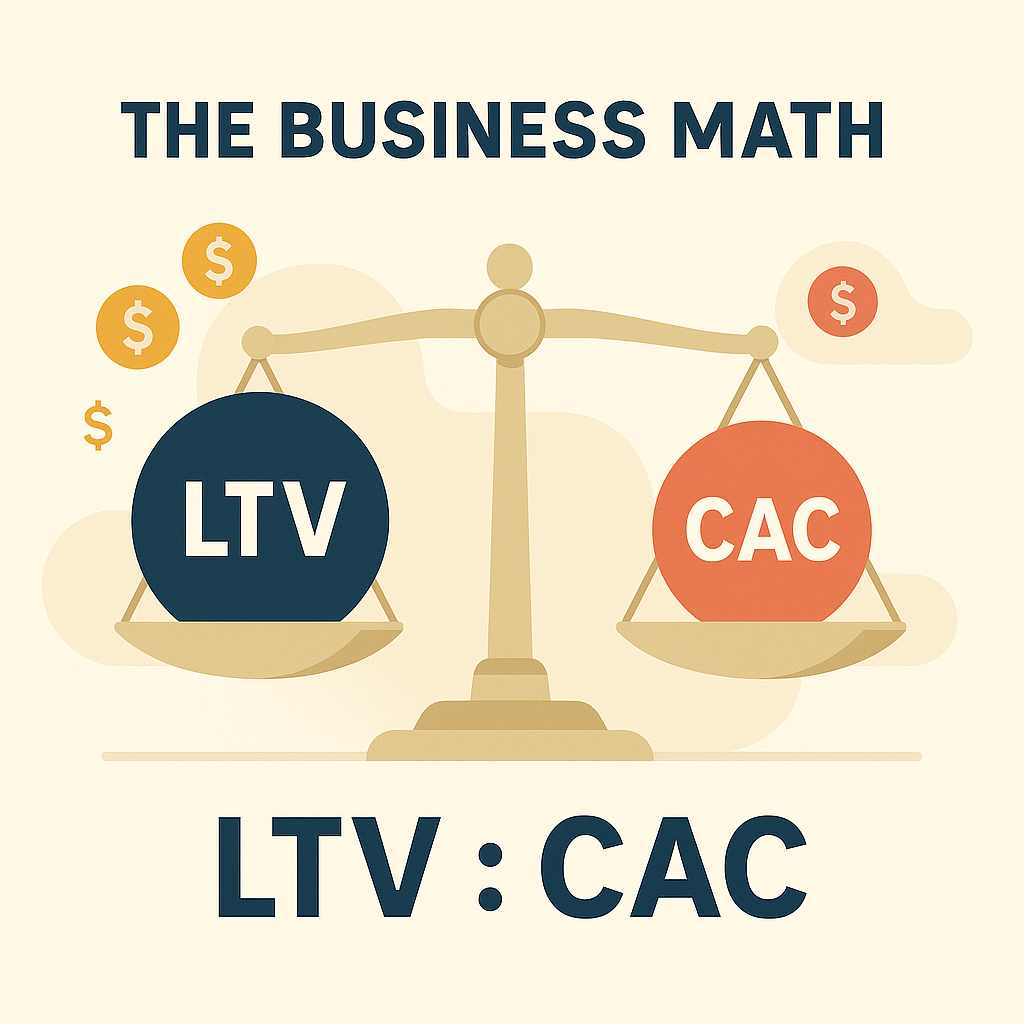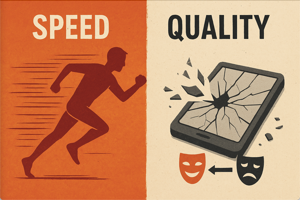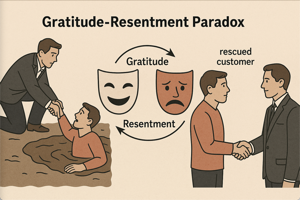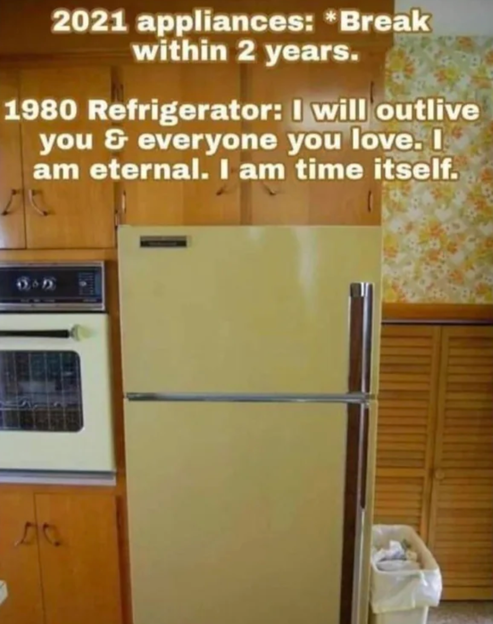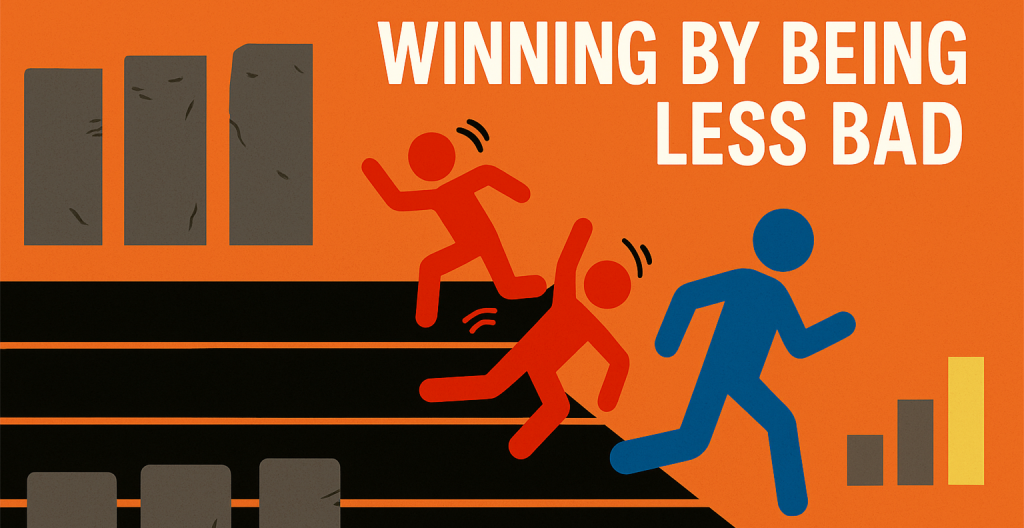
Maybe it was back-to-school season or random, but in my family we’ve recently switched multiple brands, vendors, and products for reasons from quality to service to pricing. Each move had friction: annoying phone calls, returns, learning new systems. How bad does something have to be to push customers past switching cost barriers to seek alternatives? Although I’m coming from a consumer perspective with this, it all applies to B2B as well.
I’ve shared my perspective on brand loyalty before. This is now about how average or bad is more frequent. For consumers, it’s frustrating. For product leaders, an opportunity. While quality is subjective, evidence shows decline (or at least perception of decline) recently in product and service quality. Forrester’s 2024 US Customer Experience Index reports quality among brands in the U.S. is at an all-time low, declining for a third consecutive year. Then we have The American Customer Satisfaction Index (ACSI) reporting U.S. overall customer satisfaction dropping for three consecutive quarters.
What’s behind this? Execs in the Know suggests cost cutting, bad customer service bots and lack of focus on customer satisfaction. One fundamental business ratio is Lifetime Value of Customer (LTV) and Customer Acquisition Costs (CAC). Leaving aside operating costs and understanding there are variations by industry… For the LTV:CAC ratio, at 1:1 you’re breaking even, 3:1 you’re likely healthy. Below 2:1 chances are you have thin margins and below 1:1 you’re losing money. LTV:CAC is a lagging indicator because churn and retention metrics might take awhile to show.
It’s one thing to have customers you erroneously think might be happy. It’s another to have some that can’t stand you and switching cost is the only thing barely keeping them with you.
The Irony of Progress
We have powerful and feature-rich Smartphones, TVs, computers, etc. Streaming services deliver more content. Ecommerce can drop almost anything at your door. And yet, many things feel worse. Customer service is increasingly automated but not better. Appliances are more energy efficient but break sooner. Retail experiences are misery. When quality crumbles, the “less bad” option looks appealing.
The “Less Bad” Advantage
Understanding psychology behind switching can unlock opportunities. The profitable strategic opportunities are often in new “blue oceans.” But we don’t even have to go there for wins in competitive “red ocean” marketplaces with others handing over easy wins.
Being less bad than competitors isn’t a glamorous strategy. It’s not a slide in a pitch deck likely to raise a round of capital. But consider… Decreasing churn compounds over time. Again, is this an exciting strategy? Not really. And yet, being tolerable in a sea of frustration can make you a better bet. This isn’t innovation. It’s not growth. But in a hotly competitive and commoditized market, it may offer enough advantage to keep margin and generate capital to place new bets. Now I’d like to try stretching a bit to connect LTV:CAC to MC/MR unit economics to make the point. As LTV:CAC degrades to 1 or goes below 1, the business’s Marginal Revenue (MR) or value from new customers; or rather specifically one more unit of output) is approaching or falling below its marginal cost (MC) or acquisition cost; at least roughly speaking. (OK, strictly speaking, CAC isn’t the same as marginal cost because MC includes operational costs, but functionally it behaves that way for growth businesses. It’s the marginal cost of acquiring one more unit of revenue.) As someone who’s mostly lived in startups, I get it, yet again… this is not an exciting strategy. But if you’re swimming in a red ocean, taking share can be a margin win, not just top line growth. Consider the alternative… increasing churn decreases LTV. And your marginal costs will rise. The alternative is a negative spiral in unit economics. Even if you keep growing top line revenue, profitability can deteriorate if churn worsens because you’re losing the compounding benefit of long customer lifetimes. Acquisition spend must keep climbing just to stay in place. It’s like running on a treadmill that keeps speeding up.
The Ambiguity & Illusion of Speed vs. Quality
At least for digital products, the often abused methods of Minimum Viable Product (MVP), Agile, and variants are frequently used as veneers to prioritize speed. Sometimes Minimal is emphasized over Viable. Maybe quality is assumed to be folded into “Viable” without really accepting there’s needed resource allocation to actualize this. Personally, I think we’re going to see more flights to quality soon. I’m just getting a sense that people increasingly have something we can maybe call Crapware Fatigue.
Here’s the good news for those with high quality.
- You can charge more for reliability.
- You can reduce churn, which lifts LTV.
- You can build customer goodwill simply by being the “less bad” option.
- Depending on your business, it might be challenging for competitors to match.
Others have done well being marginally better than incumbents. Zoom wasn’t as feature rich as WebEx or Teams, but during the pandemic, it worked with minimal crashes. Batteries are a commodity, but Duracell lasts somewhat longer. (Though I think as rechargeable options – like Eneloop maybe? – get better, all alkaline will be at risk for a variety of use cases.) Costco? OK, maybe a lot more than “less bad,” but, you lift your own bulk items, which you accept for the pricing and great return policies. And there’s the $1.50 hotdog and drink! Love that. The deal has its own Wiki page. Quick side story: When CEO Craig Jelinek, (in the role 2012 to 2023), took over from founder Jim Sinegal, at some point this conversation supposedly happened: “Jim, we can’t [continue to] sell this hot dog for a buck fifty. We are losing our rear ends.” According to Jelinek, Sinegal replied, “If you raise the effing hot dog, I will kill you. Figure it out.” The Power of Brand and Reputation. It can certainly be a moat. Sinegal gets it. Brand/Reputation can be just a logo and a tagline, or it can imbue ethos, pathos, magic, attachment. I’ll admit it, I’ve driven by Costco with no thought of stopping by, then swerved right in for lunch and walked out of there with an extra 10,000 of something or another. My favorite definition of brand is a promise made over time. Garbage quality experience can obviously destroy any other explicitly stated taglines.
The Old Argument About Switching
Yes, you have to be better enough to be worth switching costs. But today it’s as much that you have to be less bad than you’ve been to avoid loss. Are you complacent? Or arrogant? Being less worse than the product or service next to you seems like a rather low bar strategy, doesn’t it? Though it’s valid as increasingly poor work gets thrown into the world.
How has this happened?
At least two reasons:
- The cost of production for many goods has dropped. Optimization is about taking things out, but it’s perhaps gone too far in a variety of products and services.
- Minimum Viable Everything (except Viable is highly questionable, especially over long term) Essentially, it’s about speed over quality.
What’s the Impact
Research tells us acquiring a new customer costs up to five times more than retaining an existing one. Even a small retention boost can drastically improve profitability. A 5% increase in retention can lead to 25%–85% higher net present value, depending on industry. (See Relationship Marketing) A 10% improvement in retention can increase a company’s value by 30% (Retention rate: what it is and how to improve it.)
Switching behavior often comes down to simple triggers. According to Nielsen, top reasons consumers switch are better price (41%), better quality (26%), and better service (15%) Wiki: Customer Switching. It doesn’t take a dramatic improvement. It just has to feel comparably better.
Customer Capture… Or Rescue?
How do you feel when you get out of a bad situation?
How do you feel about anyone who helped you out of that situation?
Ironically, this could go either way. You might have strong positive feelings, or you could have a relationship where you actually resent that you owe them something. This is called the “gratitude–resentment ambivalence” or more formally the “gratitude–resentment paradox.” In psychology and social dynamics, the feeling of both appreciation and resentment toward someone who helped you is tied to the idea of indebtedness. You might have gratitude, a positive emotion for receiving help. But you might also have a feeling of indebtedness or obligation, a negative emotion that you “owe” them, which can create resentment.
Here’s the good news. From a business perspective this is less so. Let’s look at the personal level first. One reason for the feeling of indebtedness is the “debt” may feel like it touches your independence, pride, or autonomy. For example, a sibling bails you out financially. You feel grateful, but you also resent being reminded you “owe them one.” The psychological framing works like this: This is seen as social exchange, not transactional, which makes obligation more personal and sometimes more fraught.
Now, at a Company / Institutional level, the event is more transactional. Gratitude can exist, but the indebtedness often feels like part of the deal. You likely have low to zero resentment risk, because there’s lower emotional “strings attached.”
Let’s recap the core difference: Personal help: Indebtedness feels relational (“I owe you, and that complicates how I see us”). Company help: Indebtedness feels structural (“I owe the institution, and now the rules or balance of power shift”). So personal = emotional/social indebtedness, company = transactional/structural indebtedness.
End result? If you can rescue a customer from a bad situation, you can be their new best friend. And after you save them, the bar for their former brand is much higher to re-capture than it was for you to get them to switch.
What Can Businesses Do?
Be Ready to Catch
- Audit the competition’s weaknesses. Especially on basics like support and usability. Look for complaints. Look for the satisficers. Look at the customers on the edge.
- Try for less friction. Whether onboarding or elsewhere, customer success teams can boost LTV significantly (12% higher revenue growth, 19% higher margins, 25% higher CLV) Wiki: Customer Success.
- Embrace tactical quality. Make fast fixes that reduce pain, not necessarily bells and whistles.
- Own the “rescue” narrative. Market proactive empathy, not just features.
Object Lessons: Everyday Frustrations
Here’s a couple examples to drive home the point.
- Cord cutting wasn’t just a flight to features, it was and remains an escape from cable hegemony. And yet, we went from zapping ads and easy guides to endless scrolling in apps in which someone, inexplicably, didn’t include a Page Down button. Desired content is siloed in multiple services, and more. We tolerate this sometimes arguably worse experience because where we came from was worse.
- YouTube’s kid controls are so clumsy or non-existent that parents look elsewhere or block content. It’s gone from annoying to insipid. So you end up just blocking the whole thing. Some newly wealthy formerly snarky YouTubers seem to get it. So they’ve cleaned up their language. But the frenetic everything thing? Parents are starting to balk. Without easy controls to manage subscriptions to quality, poof. I don’t have studies to back up this claim. But I think it’s fair to make it based on qualitative / anecdotal evidence. (E.g., Reddit parenting forums, media critiques and more.)
None of these seem major flaws. But they’re small pushes to seek alternatives. In a world of annoyances, tolerability is a differentiator.
Last Word
With so many offerings out there below average, being great would be wonderful, but just being less bad can still win. It should be a low bar to start with. A modest quality boost can capture those fatigued by sloppy products, build lasting business, and deliver higher profit margins. In markets drowning in chaos, it’s the steady, kind, minimally flawed product that can win. Yes, yes, of course it’s even better to go from Good to Great. But that might be too expensive a jump for some. As long as others are setting the bar so low, it might be an easier reach to get to solid margins, then go from there, remembering not to just turn into the thing you just out-competed. For strategists who read this and scream, “But that’s not a sustainable competitive strategy,” they may be right. At least, it’s not as powerful as protectable intellectual property, or a unique physical plant, and so on. But the intangible of reputation can still be a powerful moat. And if you’re really a commodity? It may at least keep you in the game long enough to find a better game.
So really now, could this whole write-up have been summed up by just saying, “watch retention better?” OK, maybe. But it’s more than that. It’s a hypothesis that some of your customers may be “customer quiet quitting.” And it’s too late to keep them once this shows up in churn. Maybe see if you can find churn leading indicators like customer service resolution time or sentiment analysis during such events, especially in chatbot interactions. How often are phone trees abandoned? It might be really hard to measure things that happen mostly in silence. But that’s probably where you’re most at risk. That’s where erosion starts, emotional disengagement occurs long before your dashboards notice. Maybe you can sense those signals and adjust in time.
Maybe not energy efficient, but…
